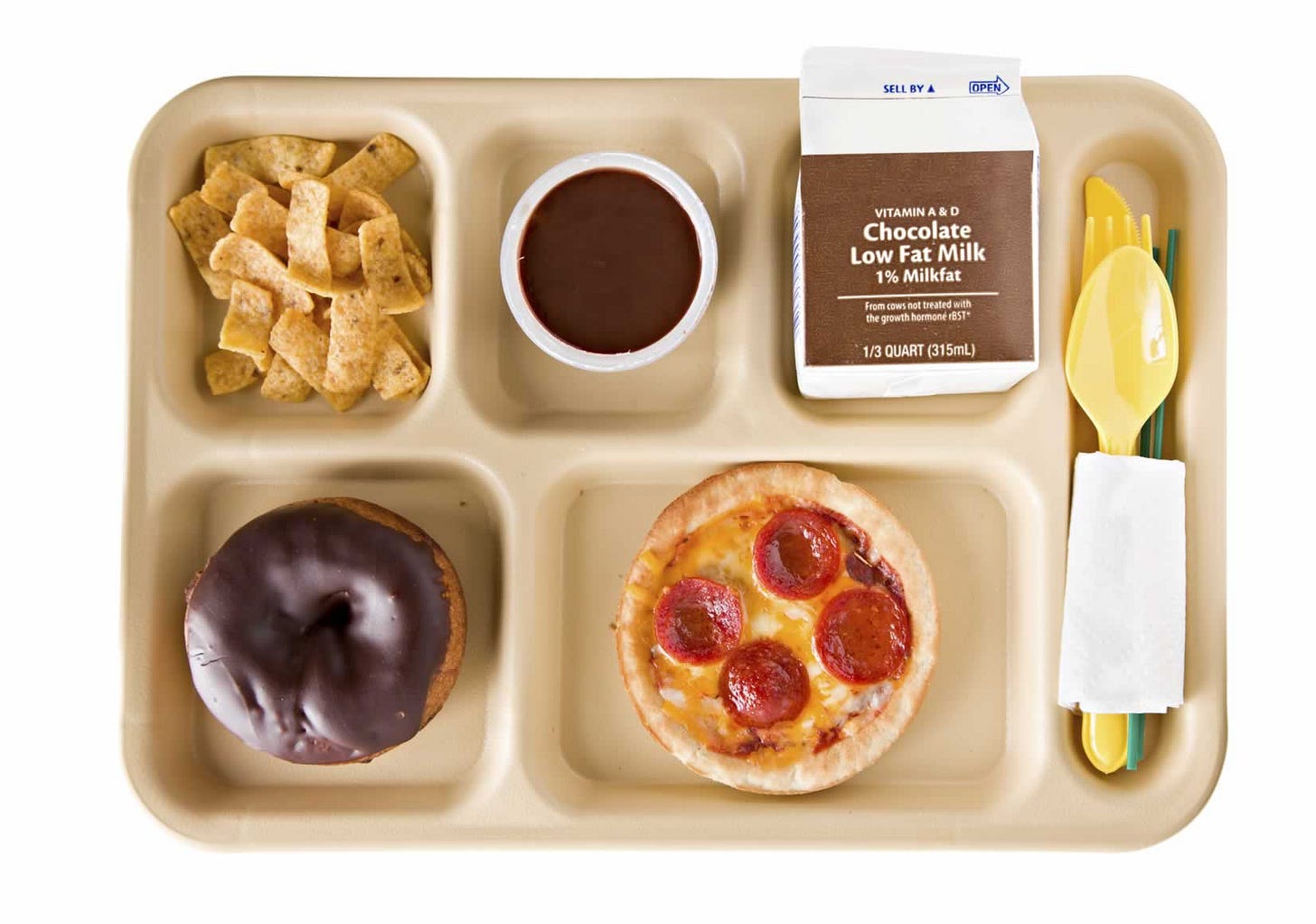By Catherine Ebeling, RN MSN, contributor, The MAHA Report
The New Yorker recently framed Robert F. Kennedy Jr.’s push for school lunch reform as well-meaning but contradictory – an impossible dream in an administration cutting federal funding for food programs while edging local farmers out.
However, the article, titled, “What Happens to School Lunches in the MAHA Era,”misses the BIG story: What Kennedy and MAHA propose is not more bureaucracy or money thrown at a broken system, but a fundamental realignment of nutrition priorities and food pipelines.
The Captured Industrial Food System
America’s school lunch program is just one example of our broken food system, hopelessly reliant on Big Food companies. Nearly 30 million children eat food that is subsidized, sourced, and regulated by the Big Food companies that directly feed the obesity, diabetes, and chronic disease epidemic. Unfortunately, the USDA’s nutrition standards were shaped by Big Food and Big Ag, not what growing children need. What’s worse – school lunches are often the healthiest and only full meal many students eat.
Current USDA regulations limit saturated fat and salt, two nutrients that make food taste satisfying and nutrient-dense, while allowing refined starches, seed oils, sugars (often in the form of high-fructose corn syrup), dyes, and other chemicals to attack our children, contributing to ADHD, insulin resistance, and obesity.
In the real world, for example, that means Vermont schools can’t serve homemade yogurt made with local maple syrup, but can serve highly processed fat-free products laced with aspartame and other chemicals. It means made from scratch pudding from full-fat, grass-fed milk is disqualified, while ultra-processed packaged desserts are given a green light. These are not real ‘whole food’ nutrition policies, they’re food-industry profit protection plans.
More Funding vs. Less Funding
Critics argue that Kennedy’s reforms can’t succeed if federal budgets tighten. But throwing money at the problem does not work. Billions of Obama- and Biden-era school food funding went mostly to Big Food suppliers like Sysco, Tyson, and General Mills – not to the small, regenerative farmers that MAHA champions.
Our school lunch system is broken. What Kennedy and Brooke Rollins are trying to do is rebuild the pipeline to create local purchasing networks that reward wholesome, real food producers instead of mega-food distributors.
RFK Jr. and the MAHA movement are calling for an “off-ramp from the current system.” An economic redesign can help make smaller, local farms viable again, so that schools can buy local food without relying on the federal grant bureaucratic maze.
Reclaim School Food from Big Corporations and Bureaucratic Control
What MAHA envisions is a return to community-supported nutrition. With this method, farmers, schools, and families work together without the bottleneck of corporate and federal interference. To do that, we must:
Change the outdated USDA guidelines that demonize saturated fats and sodium, so schools can once again use butter, whole milk, and real cheese. These are nutrient-dense foods for growing kids.
Redirect subsidies away from corn, soy, and processed commodity crops toward regenerative, pesticide-free farms.
Simplify procurement rules so schools can buy directly from nearby farms instead of purchasing food through mega food distributors.
Rebuild school kitchen infrastructure to include ovens, freezers and prep equipment through public-private partnerships, not federal red tape.
Empower states and districts to pilot MAHA-aligned “farm-to-school” models that work as examples to prove that healthy food can be affordable, local, and kid-approved.
The Human Factor: Taste and Time
In an otherwise anti-Kennedy and anti-MAHA hit piece, The New Yorker get this much right: kids need time and repeated exposure to learn to love real whole foods. “More lunch time doesn’t just offer more of a chance for physical consumption,” The New Yorkers’ Jessica Winter writes, “there’s also a hard-to-quantify value in just sitting with your food, or being near a kid who likes a food that you don’t.”
It is a difficult but not an impossible task to retrain tastebuds that are used to eating hyper palatable foods enhanced by flavorings, chemicals and dyes. But we must create an environment where healthy food tastes good, looks good, and is normal.
That starts with letting hungry kids sit down, socialize and enjoy a meal, not rushing through lunch in twenty minutes between instructional blocks. It means hiring real cooks, and teaching local educators and food-service directors to understand what healthy food looks. How MAHA’s Food Revolution Works
MAHA’s plan to rebuild school food, and restore American children’s health, combines practical action with common sense. Kennedy’s reforms aren’t abstract ideals; they’re already reshaping food policy through measurable steps that bring real food back to America’s schools.
Eliminate ultra-processed foods by moving away from Big Food suppliers and supporting real food from local farms.
Ban pesticides, synthetic chemicals, food dyes, and additives linked to ADHD and chronic illness, while cutting seed oils and excess sugar from school meals.
Bring back real butter, whole milk, and traditional fats—the foods children’s brains and bodies actually need for growth and focus.
Fast-track farm-to-school networks to connect local farmers directly with school cafeterias, ensuring fresh, chemical-free food on every tray.
Rebuild school kitchen capacity with grants, equipment upgrades, and local partnerships that make from scratch cooking possible again.
Revise federal dietary guidelines to replace outdated, Big Food-driven standards with real nutrition science, allowing healthy fats and salt, while reducing sugar, refined carbs, and additives.
Empower states and communities to lead with their own farm-to-school initiatives. States like Utah, West Virginia, and Arizona are already proving it works.
Food Freedom Is Health Freedom
To MAHA, a transformation is possible. Rebuilding the school lunch system from the ground up doesn’t require endless spending, it just requires a different system: freeing farmers and schools from bureaucratic tangles and changing the pipeline. The current model feeds corporate profits and chronic disease. MAHA’s model feeds children, farmers, communities, and our country’s future.
As Kennedy has said, “The defense of the family farm is a defense of everything America has been, and everything we will be.”
This is truly at the heart of the MAHA movement – and the real food revolution as well.






Thank the Lord for Bobby Kennedy Jr giving this Trump administration the direction to truly Make America Healthy Again.
Farm to School~ Couldn't be more simple...and a sound, SANE foundation for our nation's children developing well~ physically, mentally, all-around healthy!
"...letting hungry kids sit down, socialize and enjoy a meal, not rushing...".
"...once again use butter, whole milk, and real cheese. These are nutrient-dense foods for growing kids...".
"Ban pesticides, synthetic chemicals, food dyes, and additives."
“The defense of the family farm is a defense of everything America has been, and everything we will be.”
A hearty round of applause👏👏👏 for HHS's Bobby, and FDA's Brooke, for fighting the good fight on behalf of America's future foundation~ our children; promising to protect their health and well-being, and ACTING ON THAT PROMISE‼️
***
And, thank you, Nurse, Catherine Ebeling for writing this wellness piece that clearly hits home on what is being done (feed children whole, nutritious foods like real butter & milk, while totally eliminating poison like preservatives, dyes, etc.), and what needs to be done (ban crop toxins, regenerate/build up the soil organically/truly naturally, & support farmers who reject CorPIRATE subsidies, and that take this sacred duty on-- the re-enriching of our nation's soil & food)‼️